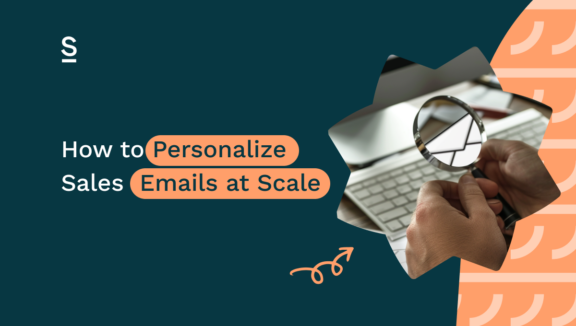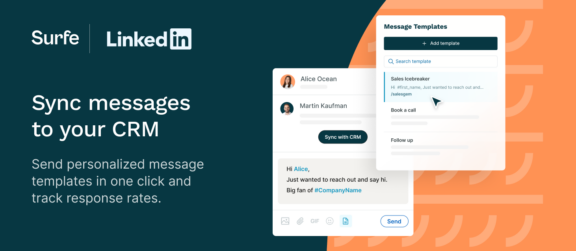How to Personalize Sales Emails at Scale

If we had a dollar for every time someone told us that personalization is the key to a successful email campaign, we wouldn’t be working in sales anymore.
In fact, we wouldn’t be working at all – we’d be millionaires!
These days, personalization is touted as the gold standard of email outreach – and with good reason. Personalized emails get a 14% higher click-through rate, while personalized subject lines see a 29% higher rate of opens compared to non-personalized emails.
But just because something is good to do, doesn’t mean it’s easy – quite the opposite, in fact. When you’re working with hundreds or even thousands of leads, balancing automation with personalization and keeping things at a high standard is really, really difficult.
Don’t worry, though – we’re here to help. This blog post is going to give you all the strategies and tools you need to efficiently personalize your email outreach at scale. Here’s what we’re going to cover:
- Why Personalization is Critical for Sales Emails
- Using Data to Drive Personalization
- How to Scale Personalization with Automation
- Tools for Scaling Personalization
You’ll come away understanding everything – we mean everything – you need to do to successfully personalize emails at scale. You’ll even stop rolling your eyes at people who tell you to personalize your email outreach. In fact, you’ll find the words coming out of your own mouth instead!
Time to get started.
Why Personalization is Critical for Sales Emails
We’re sure we don’t need to tell you that people LOVE to feel special. Everyone thinks the world revolves around them – don’t pretend you’re any different 😉. Conversely, they don’t want to be reminded that they’re just one of millions and millions.
With that in mind, you can understand why personalization gets such good results: done well, it makes people feel heard, understood, and, well, special.
Personalize your emails successfully, and you’ll be looking at results like:
- Increased Engagement: you’ll see metrics like open rates, click-through rates and response rates go through the roof.
- Building Relationships: tailor your emails, and you’re building stronger, more meaningful connections with your prospects. After all, you understand them – right?
- Standing Out: how many unopened emails do you have right now? Exactly. Inboxes are crowded, and personalized content helps your message stand out from generic or mass emails.
Got it? Good. Let’s keep moving.
Key Elements of Personalization in Sales Emails
You’re convinced – but what does personalization actually look like in the modern-day sales email?
Subject Lines
This could be on the basic side, like referring to the recipient or the business they work for by name. Or, you could get a little more fancy and add specific details about the recipient’s pain points or interests. Tip: only refer to interests if it’s actually relevant to what you’re selling. Why? Well, imagine how sad you’d be if you thought someone wanted to chat hobbies with you, but when you opened their email all you found was a sales pitch. Exactly.
Body Content
Here you want to dig deep into specific needs, pain points or solutions that are relevant to your prospect. For example, you might reference a common problem people who share their job title have, or maybe you spotted a company milestone on LinkedIn and want to congratulate them. And how your email’s introduction should be gripping.
Call to Action (CTA)
This is a personalization opportunity that lots of salespeople don’t take. Keep your CTAs generic (for example: “Let’s schedule a call”) and you’re missing the chance to hammer home the benefits of your product, or reasons why they should reply to you. Take a CTA like “Let’s discuss how we can help your team increase lead conversion by 30%” – you’re ending strong on a note that shows exactly why your product’s so good.
Ok, we’ve covered why you should personalize your outreach emails and where you should include personalization in them. Next up, how do you know what to say in the first place?
Using Data to Drive Personalization
The answer lies in one of our favorite things: data! Here’s how to use different types of data to find out exactly what you should say when you personalize:
CRM Data
CRMs contain valuable information about your prospects, like job title, company size and previous interactions. You can use these to tailor your emails – a 20-person startup is going to require different messaging than a 2000-person corporate, for example.
Behavioral Data
Use behavioral data, website activity, email engagement (opens and clicks), and social media interactions to guide your messaging. For example, you could reference something your prospect posted on LinkedIn in your opening line. Tracking tools like Uplead and Clearbit make this easy to do at scale – they enrich your contact list with loads of data points (like seniority, department and team, to name a few). Cherry pick from these to inform what you say.
Segmentation
It’s likely not everyone on your email list is going to share the same job title, industry or behaviors – segment your list along these lines to keep your messaging super relevant to each person.
By now, you should be feeling pretty confident about the ins and outs of outreach personalization – but how do you do it at scale?
How to Scale Personalization with Automation
In a nutshell – you use technology to help you. Let’s run through the major ways to scale personalization.
- Email Templates with Dynamic Fields: tools like Outreach or Salesloft use templates that pull personalized data – like recipient name, company or recent activity – automatically. You can then check these and make tweaks to make sure your personalization nails it every time.
- Merge Tags: every major email marketing tool should have these. Insert them into your email templates to automatically add personalized details like recipient names, job titles or locations.
- Automated Email Sequences: this is where things get really clever. You can build automated email flows that adjust based on the recipient’s behavior. For example, if your recipient opens an email several times and clicks on the link inside it you might automate a follow-up with another email on the same topic – it obviously resonated, after all! If they don’t open it at all, you might try the same email but with a different subject line.
Tools for Scaling Personalization
We know what your next question is going to be. What are the best tools for scaling personalization?
The good news is you probably already have one of these in your rotation – which means you can start personalizing today!
- CRM Tools: you can segment your lists and pull in key contact details using merge tags with CRMs like Salesforce and Hubspot.
- Email Marketing Tools: tools like Mailchimp, ActiveCampaign, or Reply.io offer personalization options with automated workflows and dynamic content insertion, depending on who the email’s going to and how they react to it.
- Sales Enablement Platforms: platforms like Salesloft and Outreach will help you to create cadences with personalized content at every stage of the sales cycle. They keep an eye on signals from your buyers and use this to direct your next action. Magic.
- Surfe: Ok, it might not be email, but there’s a super easy way to reach out to your LinkedIn contacts, at scale, with personalized messaging. Set up a template for your LinkedIn messages and send it out including personalized variables to LinkedIn contacts in just one click. Saves you a bunch of time if you’re someone who sends a lot of LinkedIn DMs.

Best Practices for Personalizing Sales Emails at Scale
We’re almost there. Next up – how can you take your personalization at scale efforts from good to great?
- Keep it Relevant: including basic personalization like your recipient’s name is an absolute minimum. It’s important because everyone expects it – but that doesn’t mean you can wash your hands of personalization as soon as you’ve included it. Quality personalization means being hyper-relevant: referring to role, industry or company pain points, for example.
- Limit Over-Automation: automation is great, but there is a slight risk of sounding like a robot if you overdo it. Remember when we said that everyone likes to feel special? They’re not going to feel special if they cotton on you’re automating your emails. Sorry. Once your prospect has shown positive interest – for example, by replying to your email – you’re going to want to make things personal.
- Test and Optimize: the world of B2B sales changes – a lot. Continuously A/B test personalized subject lines, body content and CTAs to see what resonates most with your audience. Analytics like open rates, response rates and conversion data will tell you what to keep, and what you need to switch up.
Want to know more about measuring success? Just call us mind-readers…
Measuring Success
As we mentioned above, you’ll want to measure success to make sure that your personalization is working. Otherwise, you could be flogging a really dead horse – and scaring your prospects off in the process. Key metrics to track include:
- Open Rates: this means the rate at which your emails are opened – and in turn, the rate at which they’re ignored. Use these to judge how personalizing your subject lines is going for you.
- Click-Through Rates: in other words, are people actually reading what you’re writing? Are they interested enough to find out more? The higher the click-through rate, the better you’re doing – keep it up!
- Response Rates: if you get a reply to your email, you know you’ve nailed your personalization for this recipient. If you’re getting replies at scale, you know your strategy is working.
- Conversion Rates: we’re going to assume that you want your emails to result in your prospects booking a demo, or something similar. If this happens regularly, your conversion rates are high. If not so much, you might need to try personalizing more, or maybe making sure you’re not over-automating.
Let’s Wrap It Up!
Personalizing email outreach at scale is critical for the modern B2B sales rep – and it doesn’t have to be too difficult, either. Get your placement just right, use data and tools to help you, keep best practices in mind and make sure you’re always testing and learning, and you’ll be well on your way to millionaire status yourself.
Don’t forget to lend us a tenner when you get there, will you?

It’s time to get personal.
Ready to wow your prospects with your in-depth knowledge? Of course you are – but to do that, you’ll need their contact details. And that, our friends, is where Surfe comes in.
FAQs About Personalizing Sales Emails at Scale
How To Make Emails Personalized?
There are plenty of ways to make your emails personalized, ranging from the basic to the more advanced. At a basic level, you’ll want to refer to your recipient’s name and the name of their business. To really successfully personalize an email, though, you’ll want to refer to pain points they might be experiencing as part of their job role or as a member of their specific industry. Another way to successfully personalize your emails is to refer to your recipient’s online activity – maybe they wrote an insightful post on LinkedIn or have visited a certain page on your website multiple times.
How Do I Send a Mass Email That Looks Personalized?
You can automate several parts of the personalization process, which allows you to send a mass email that looks personalized. Email templates with dynamic fields, merge tags and automated email sequences that adjust based on the recipient’s actions all make your email seem hyper-personal, even if it’s been sent to hundreds or even thousands of people. Tools like CRMs, email marketing tools and sales enablement platforms also help you with personalization at scale.
How To Personalize Outbound Emails?
Personalize outbound emails by referring to things that you know will appeal to your prospects. This could be something like referring to some news their business just published or an interaction you had on LinkedIn, using their first name or referring to a pain point in your subject line, or personalizing your CTA based on an outcome their persona tends to desire. You can use CRM and behavioral data to figure out what these might be.
How Do I Customize My Emails?
To successfully customize your emails, think about how you can personalize them at every stage of the recipient’s journey. For example, call out their name or a pain point in the subject line, make sure the body content is hyper-relevant by mentioning a shared interest or industry case study, and make sure your CTA hammers home the benefit of clicking through or responding to your email.


